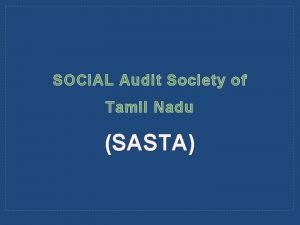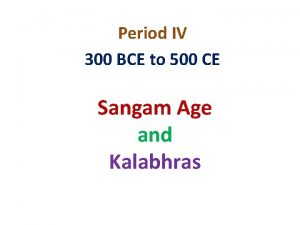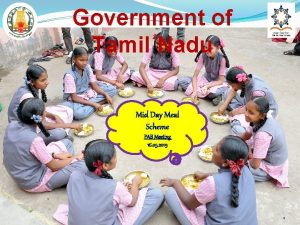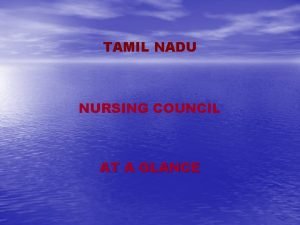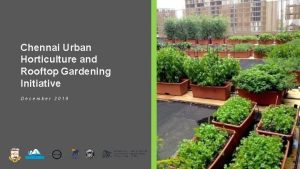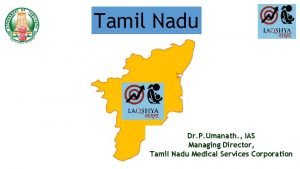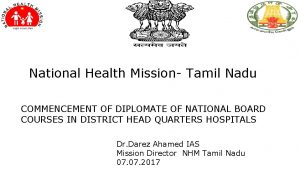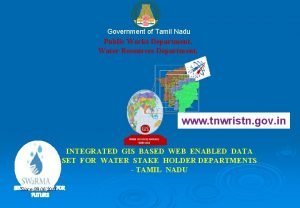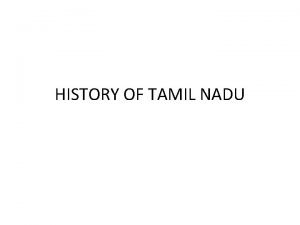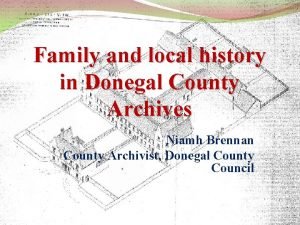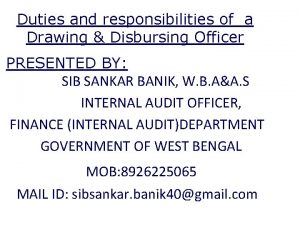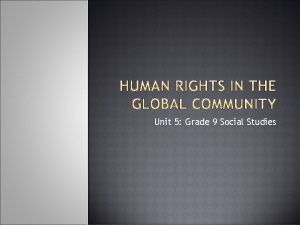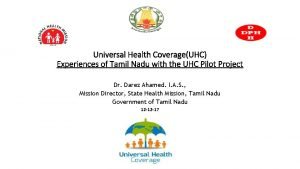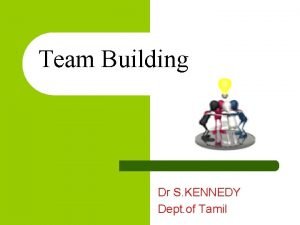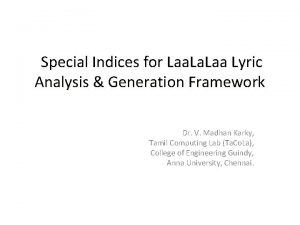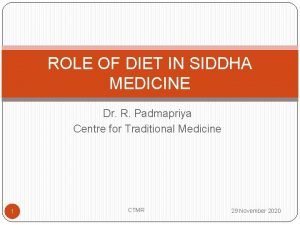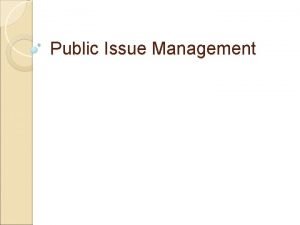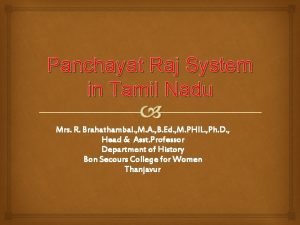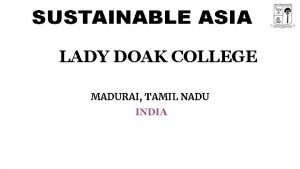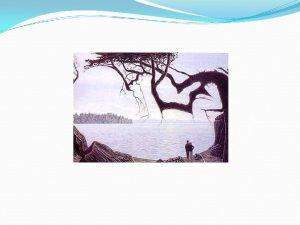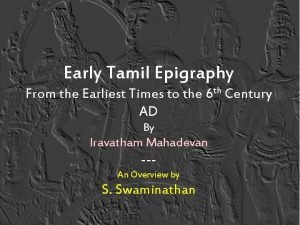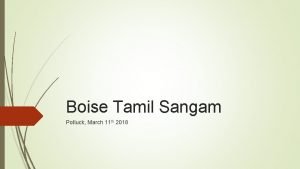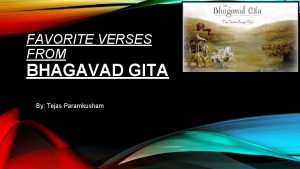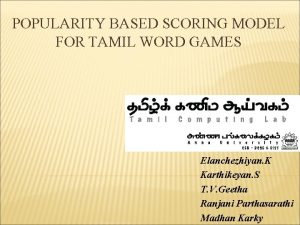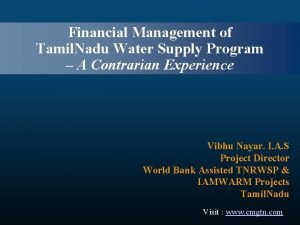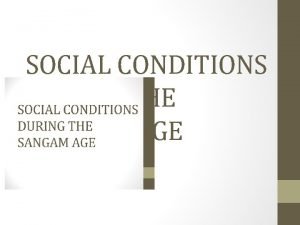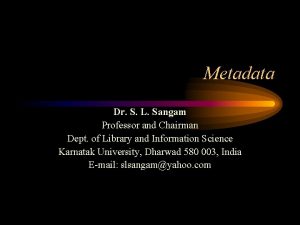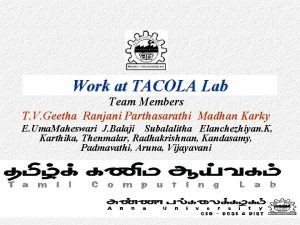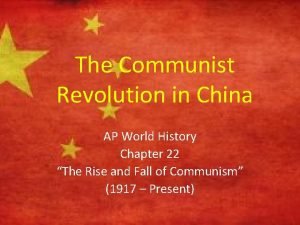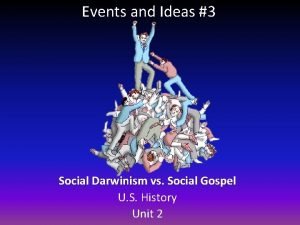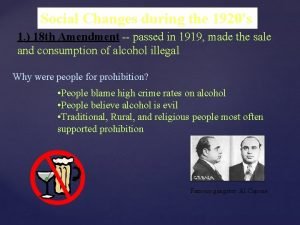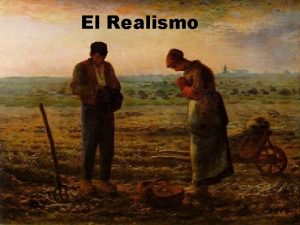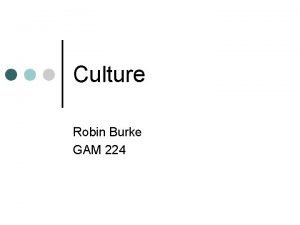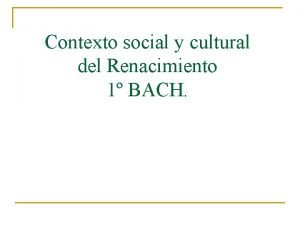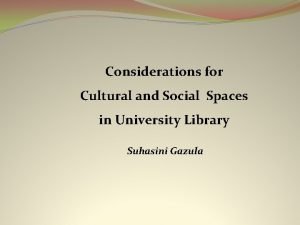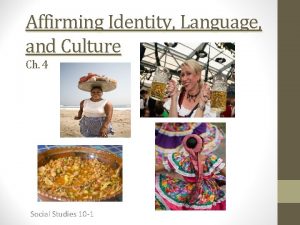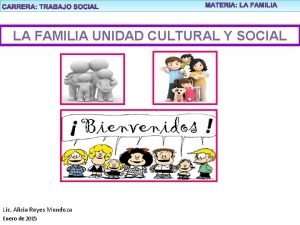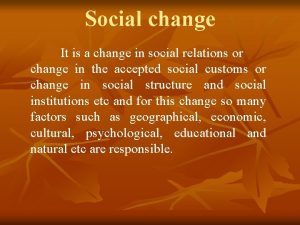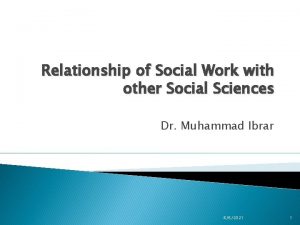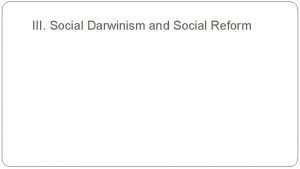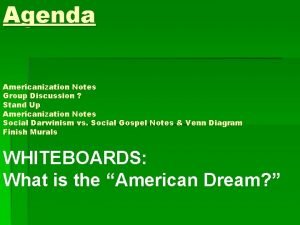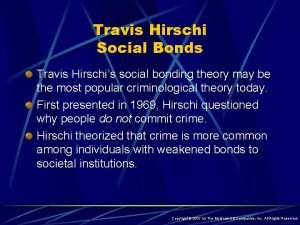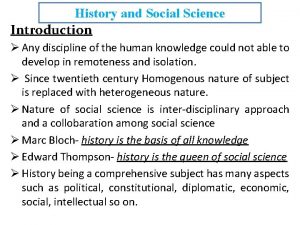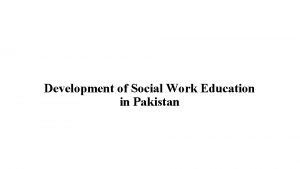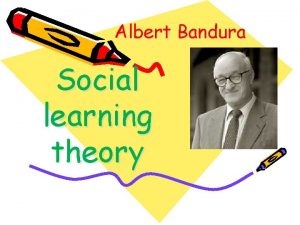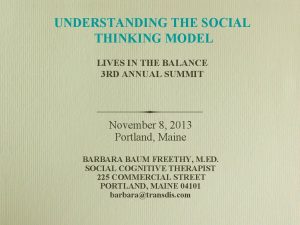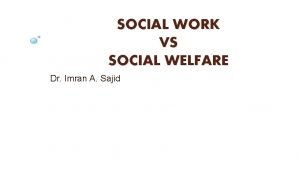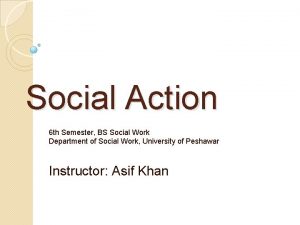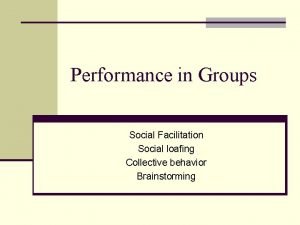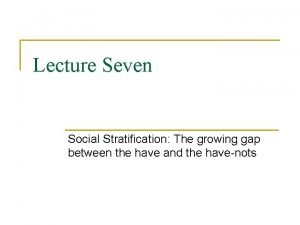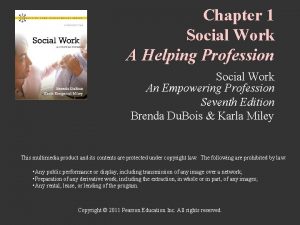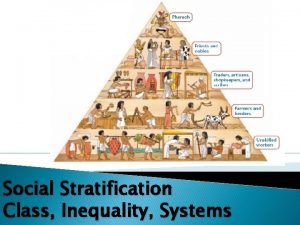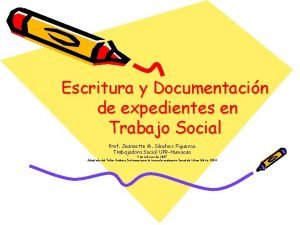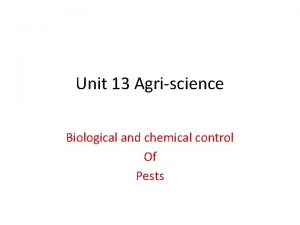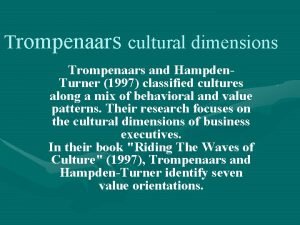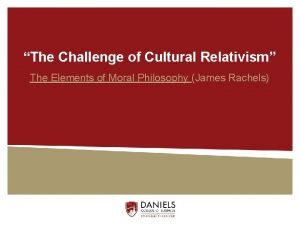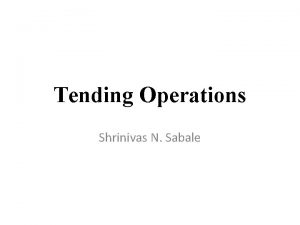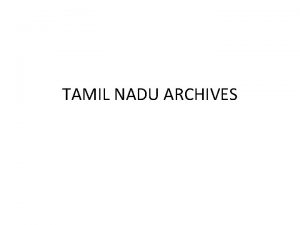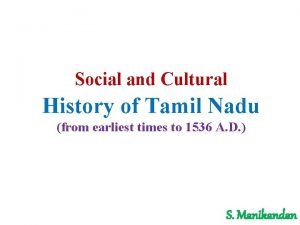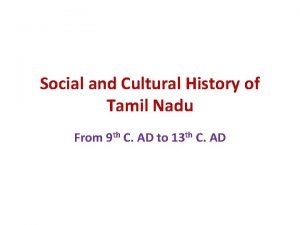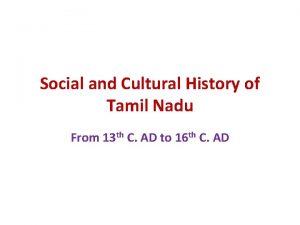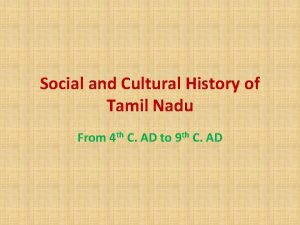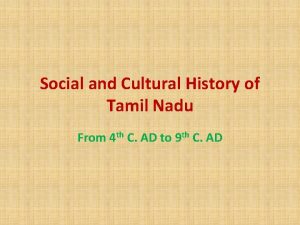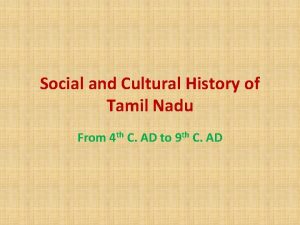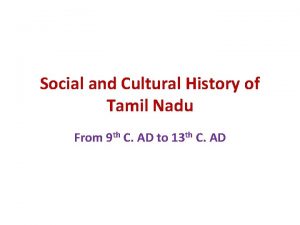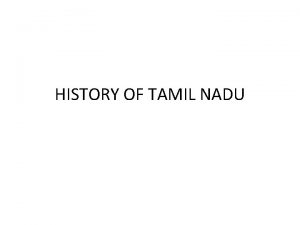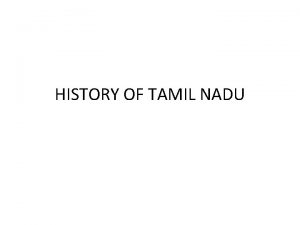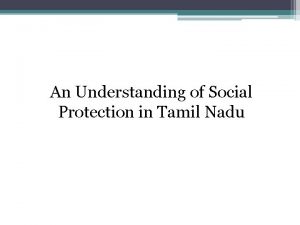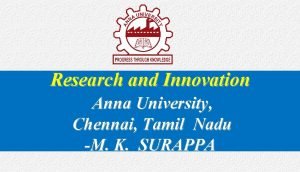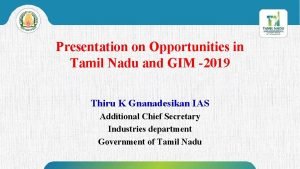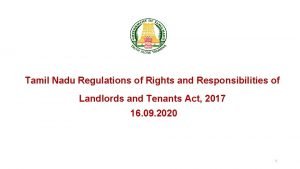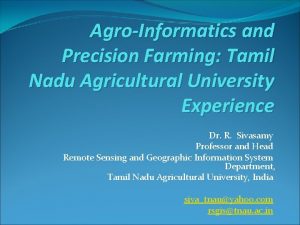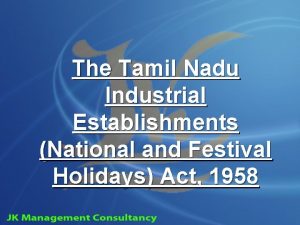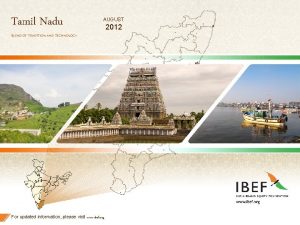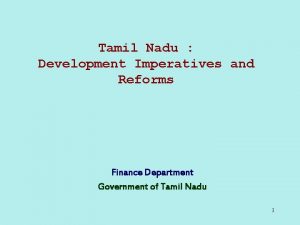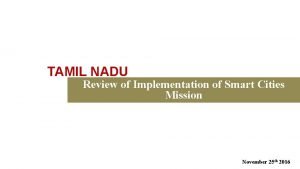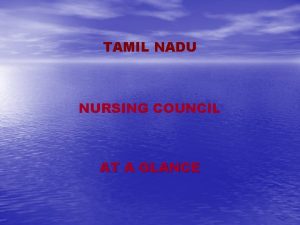Social and Cultural History of Tamil Nadu from




















































































- Slides: 84

Social and Cultural History of Tamil Nadu (from earliest times to 1536 A. D. ) S. Manikandan

Ø Sources ØChronology ØGeographical Settings of Tamil Country

Sources

Three type: Ø Archaeological Sources Ø Literary Sources and Ø Oral Sources

Archaeological Sources üArchaeology, or archeology, is the study of human activity through the recovery and analysis of material culture. üThe archaeological record consists of artifacts, architecture, biofacts or ecofacts, and cultural landscapes. üArchaeology can be considered both a social science and a branch of the humanities.

Archaeological Sources üMaterial remains üCoins üInscriptions

Sources Archaeological Sources Material Remains

Rock Art (Paintings)

Archaeological Sources üCoins - Study of coins is called Numismatics

Archaeological Sources üInscriptions - Study of Inscription s is called Epigraphy

Estampage

Script on Pottery

Method of Collecting Archaeological Evidence 1. Exploration Method 2. Excavation Method

Layer of soil formation

Exploration Method

Habitation Mound

Burial Site

Coirn Circle with Cap Stone

Hero Stones

Excavation Method

Trenches

Antiquities

Potteries

Literary Sources ü Source literature is a term with different meanings. Literature (understood as printed texts) is one kind of information source. ü In a way, all literature is a kind of source literature. It might, for example, be cited and used as sources in academic writings.

Literary Sources üPalm Leaves üAnimal Skin üClothes üRecords üBooks

Palm Leaves • the leaf or frond of a palm tree, especially that of a fan palm, used in making fans, hats, thatch, mats, etc.

Animal skin • A hide or skin is an animal skin treated for human use.

Clothes • items worn to cover the body.

Records • a thing constituting a piece of evidence about the past, especially an account kept in writing or some other permanent form.

Text Books • a written or printed work consisting of pages glued or sewn together along one side and bound in covers.


Oral Sources Oral history is the collection and study of historical information about individuals, families, important events, or everyday life using audiotapes, videotapes, or transcriptions of planned interviews.

Oral Sources üBallads üFolksongs üStories

Ballads a poem or song narrating a story in short stanzas. Traditional ballads are typically of unknown authorship, having been passed on orally from one generation to the next.

Folksongs a song that originates in traditional popular culture or that is written in such a style.

Stories an account of imaginary or real people and events told for entertainment.

Three Level of Sources – Primary sources – Secondary sources – Tertiary sources

Primary sources • Primary sources allow researchers to get as close as possible to original ideas, events and empirical studies as possible. • Such sources may include expositions of creative ideas, first hand or contemporary accounts of events, publication of the results of empirical observations or studies, and other items that may form the basis of further research. • Examples include: – – Novels, plays, poems, works of art, popular culture diaries, narratives, autobiographies, memoirs, speeches Government documents, patents Data sets, technical reports, experimental research results

Secondary sources • Secondary sources analyze, review or restate information in primary resources or other secondary resources. • Even sources presenting facts or descriptions about events are secondary unless they are based on direct participation or observation. • Moreover, secondary sources often rely on other secondary sources and standard disciplinary methods to reach results, and they provide the principle sources of analysis about primary sources. • Examples include: – – Biographies Review articles and literature reviews Scholarly articles that don't present new experimental research results Historical studies

Tertiary sources • Tertiary resources provide overviews of topics by synthesizing information gathered from other resources. • Tertiary resources often provide data in a convenient form or provide information with context by which to interpret it. • Examples include: – – Encyclopedias Chronologies Almanacs Textbooks

• Context determines whether a source is primary, secondary or tertiary. • Sources that are normally considered to fit into one category may sometimes be used as another. • For example, encyclopedias are normally used as tertiary resources, but a study of how encyclopedias have evolved through time would probably use them as primary sources. • Each discipline has its own set of standards for what counts as a primary source.

Chronology Timeline of Tamil Country

• The entire range of the human history of Tamil Country from pre-historic times to c. 16 th c. CE has considered here. • Tamil Country is recognized as a complex region with diverse physical, social and cultural components. • For the sake of convenience, the area covered by the two present-day linguistic states of Tamil Nadu and Kerala is taken as the macro-region of South India. • Nevertheless, the boundaries cannot be treated as rigid and fixed in tracing human development. • Moreover, due to the vastness of the study area, the historical characteristics of the region are bound to vary from area to area at sub-regional level.

Cont… • Considered at the macro-regional level, the history of Tamil Country is broadly divided into seven periods based on salient technological, social and cultural features. • Though there would be some overlapping among the different continuous periods at both the macroregional and sub-regional levels, this periodization is necessary to understand the cumulative historical changes. • The time divisions are only indicative and they do not mean that there was a sudden shift from one culture (or way of life) to another; it only implies the advent of a new culture.

Chronology of Social and Cultural History of Tamil Country • • Period III Period IV Period VII - 1 myr BCE – 3000 BCE 1000 BCE – 300 BCE – 500 CE – 900 CE – 1300 CE – 3000 BCE 1000 BCE 300 BCE 500 CE 900 CE 1300 CE 1600 CE

1 (c. 500 -900 CE) Period IV Period V 2 Pre – Historic Period 3 4 (c. 1300 -1600 CE) (c. 300 BCE-500 CE) Period III (c. 900 -1300 CE) (c. 1000 -300 BCE) (c. 3000 -1000 BCE) (c. 1 myr-3000 BCE) Period II Period VII 5 Historic Period 6 7

Geographical Features of Tamil Nadu

Tamil Nadu • Situated in the Southern part of the country, Tamil Nadu is one of the most well known and important states in India. • Andhra Pradesh forms the Northern border for it, whereas Karnataka and Kerala lie on its northwest and west respectively. • Two water bodies that enclose the state on the southern and the eastern sides are the Indian Ocean and the Bay of Bengal respectively. • In fact, geometrically, Tamil Nadu touches the extreme southern tip of the Indian Peninsula. The total area of the state is 1, 30, 058 square km. Chennai, earlier known as Madras, is the capital of Tamil Nadu which is the fourth largest city in India with an area of approximately 175 square km.


Outline of Map of Tamil Nadu

Facts on Tamil Nadu Official Website Date of Formation Area Density Total Population (2011) Males Population (2011) Females Population (2011) No. of District Capital Rivers Forests & National Park www. tn. gov. in Jan 26, 1950 130, 058 sq km 555/Km 2 72, 147, 030 36, 137, 975 36, 009, 055 32 Chennai Kaveri, Thamirabarani, Vaigai, Chittar, Manimuthar etc. Mudumalai NP, Mukurthi NP, Annamalai NP, Indira Gandhi WS and NP. Languages Tamil, Telugu, Malayalam, Kannada, Urdu, English Neighbours State Animal State Bird State Tree State Flower Net State Domestic Product (2011) Literacy Rate (2011) Females per 1000 males Assembly constituency Parliamentary constituency Kerala, Karnataka, Andhra Pradesh Nilgiri Tahr Emerald Dove Palmyra tree Glory lily 72993 69. 72% 995 234 39

N Indian Subcontinent

Satellite Map of Indian Subcontinent N

G e o g r a p h i c a l L o c a t i o n 3 D View of Indian Subcontinent N I n d i a n S u b c o n ti n e n t

Physical Map of South India N

Political Map of South India

Political Map of Tamil Country N

Satellite Map of Tamil Country N

Physical Features ü ü ü ü ü Boundary Ghat Hill Valley River Pass Plain Island Coast Plateau

Boundary ü a line which marks the limits of an area; a dividing line.

Boundary of Tamil Country Vadavenkadam (Tirupathi) N Bay of Bengal Arabian Sea Then Kumari (Kanniya Kumari) Indian Ocean

Ghat ü a flight of steps leading down to a river.

Ghat N Eastern Ghat Western Ghat

Hill ü a naturally raised area of land, not as high or craggy as a mountain.

Tirupathi / Servarayan hill Nilgiri Hill Javadu Hill Gingee Hill Kalrayan Hill Pachchaimalai Kolli Hill Anaimalai Palani Hill Alagarmalai Agastiya Hill N

Valley • a low area of land between hills or mountains, typically with a river or stream flowing through it.


River ü a large natural stream of water flowing in a channel to the sea, a lake, or another river.


Vellar Gundaru Pazhayaru

Pass ü move or cause to move in a specified direction.

N Palakkad Pass Senkottai Pass Aralvaimozhi Pass


Plain • a large area of flat land with few trees.


Island ü a piece of land surrounded by water.

Island N Cylone / Lanka / Srilanka Katchcha theevu

Coast ü the part of the land adjoining or near the sea.

Coast N Malabar Coast Coromondal Coast

Plateau ü an area of fairly level high ground.



Dravidian Languages

Theory of Kumari Kandam
 Social audit society of tamilnadu
Social audit society of tamilnadu Sri lanka tamil
Sri lanka tamil Go 354 tamil nadu
Go 354 tamil nadu Mid day meal scheme poster
Mid day meal scheme poster Introduction of tamil nadu
Introduction of tamil nadu Urban horticulture
Urban horticulture Chief minister special cell in tamil
Chief minister special cell in tamil Umanath ias family
Umanath ias family Nhm tamilnadu
Nhm tamilnadu Tamil nadu public works department
Tamil nadu public works department Nadu meaning in history
Nadu meaning in history Nadu donegal
Nadu donegal Drawing officer meaning
Drawing officer meaning Dream big and dare to fail meaning in urdu
Dream big and dare to fail meaning in urdu Apa itu social thinking
Apa itu social thinking Social thinking social influence social relations
Social thinking social influence social relations Moral social and cultural studies grade 9
Moral social and cultural studies grade 9 Universal health coverage in tamil
Universal health coverage in tamil Norming meaning in tamil
Norming meaning in tamil Tamil kuril letters
Tamil kuril letters Thurinji manapagu
Thurinji manapagu Issue management meaning
Issue management meaning G. v. k. rao committee
G. v. k. rao committee Help ever hurt never meaning in hindi
Help ever hurt never meaning in hindi Sdg 11
Sdg 11 Keva silver
Keva silver Panel discussion meaning in tamil
Panel discussion meaning in tamil Oldest tamil inscription
Oldest tamil inscription Potluck meaning in tamil
Potluck meaning in tamil Maksud sekolah vernakular sejarah tingkatan 4
Maksud sekolah vernakular sejarah tingkatan 4 Sarva dharman parityajya sloka meaning
Sarva dharman parityajya sloka meaning Kalviamuthu.blogspot.com
Kalviamuthu.blogspot.com Random tamil word generator
Random tamil word generator Vibhu nayar ias
Vibhu nayar ias Example of rheonomic constraints
Example of rheonomic constraints Tdejiw6qmka -site:youtube.com
Tdejiw6qmka -site:youtube.com California tamil academy books
California tamil academy books Circled letters font
Circled letters font Social conditions of sangam age
Social conditions of sangam age What is open for delivery
What is open for delivery Sangam mulmi
Sangam mulmi Ranjani meaning in tamil
Ranjani meaning in tamil Average size of female organ
Average size of female organ Smart grid meaning in tamil
Smart grid meaning in tamil Communism in china ap world history
Communism in china ap world history Social darwinism vs social gospel
Social darwinism vs social gospel Social/cultural changes during the 1920's
Social/cultural changes during the 1920's Realismo europeo caracteristicas
Realismo europeo caracteristicas Cultural vs social
Cultural vs social Contexto historic
Contexto historic Cultural vs social
Cultural vs social Affirmation of identity social studies
Affirmation of identity social studies La familia unidad cultural y social
La familia unidad cultural y social El romanticismo contexto social
El romanticismo contexto social Cultural social
Cultural social Nature of social change
Nature of social change Cultural social
Cultural social History also history physical
History also history physical Difference between social action and social interaction pdf
Difference between social action and social interaction pdf Relationship of social work with other social sciences
Relationship of social work with other social sciences Social thinking and social influence in psychology
Social thinking and social influence in psychology Lesson 3 social darwinism and social reform
Lesson 3 social darwinism and social reform Social darwinism and social gospel venn diagram
Social darwinism and social gospel venn diagram Social darwinism vs social gospel
Social darwinism vs social gospel Global agenda for social work and social development
Global agenda for social work and social development Hirschi bonds of attachment
Hirschi bonds of attachment Social thinking and attribution theory
Social thinking and attribution theory History in social science discipline
History in social science discipline School social work in pakistan
School social work in pakistan Social learning theory history
Social learning theory history Brief history of social psychology
Brief history of social psychology Social thinking social learning tree
Social thinking social learning tree Social welfare vs social work
Social welfare vs social work Principles of social action in social work
Principles of social action in social work Social facilitation vs social loafing
Social facilitation vs social loafing Objectives of group work in social work
Objectives of group work in social work Social stratification vs social inequality
Social stratification vs social inequality Social gospel vs social darwinism
Social gospel vs social darwinism Social work: an empowering profession 9th edition chapter 1
Social work: an empowering profession 9th edition chapter 1 Social hiearchy
Social hiearchy Expediente en trabajo social
Expediente en trabajo social Agriscience unit 13 completion answers
Agriscience unit 13 completion answers Trompenaars and hampden-turner cultural dimensions
Trompenaars and hampden-turner cultural dimensions Ethical relativism
Ethical relativism Tending operations in forestry
Tending operations in forestry
